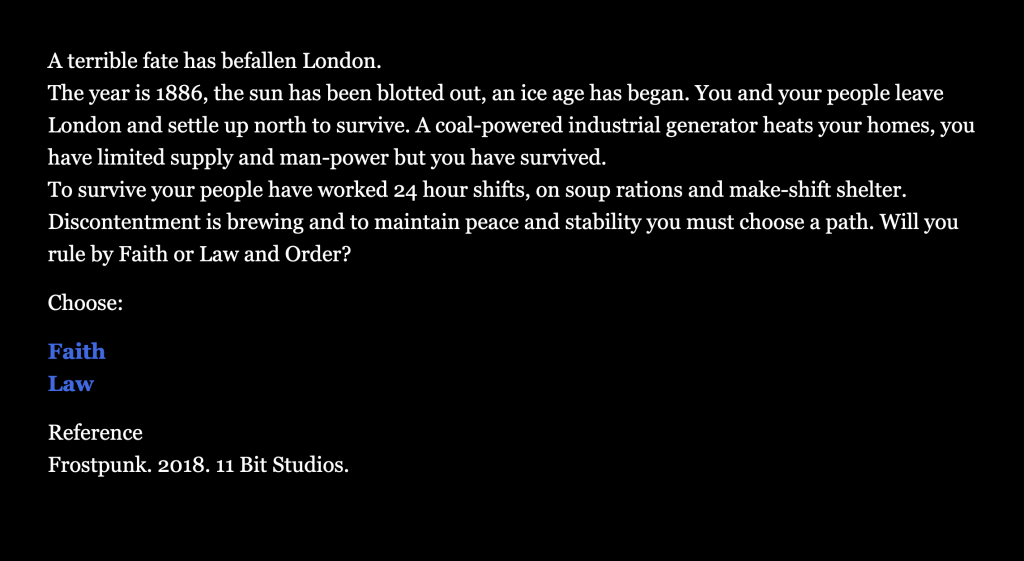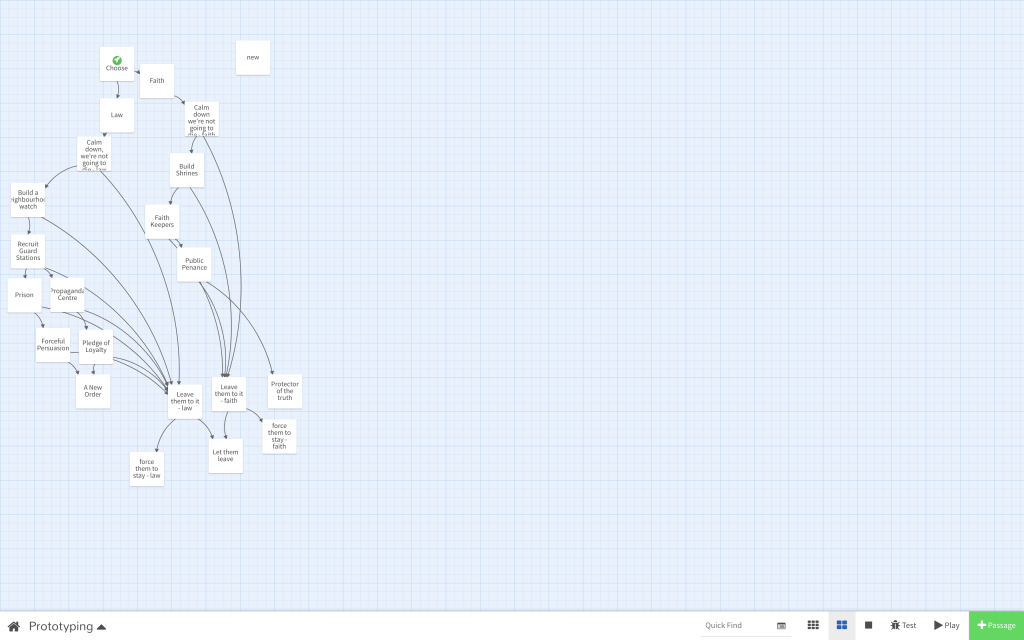“One of the best ways to hone your prototyping skills is to reverse engineer the finished work of other practitioners you admire. This allows you to practise with the various tools and unpack the design theory behind the work in question. To complete this activity, identify an artefact you feel is particularly interesting. This could be anything from an inventory system UI for a game to a museum website that utilises AR or VR. The more experimental and interactive the artefact you choose, the more challenging this prototyping activity will be. This is an extremely open brief designed to allow you the freedom to choose an artefact you will find enjoyable to reverse engineer. We want you to dive in and have some fun. Don’t take the task too seriously – instead, enjoy trying to get inside the minds of other creative practitioners” (Falmouth University 2020)
Challenge Activity

A Frostpunk Prototype
Technique 8: Narrative Prototyping
My Frostpunk based story was made using Twine and is available at https://impalpably.github.io/week-3-challenge/
Twine is my weapon of choice this week “Twine can be used to prototype long conversations, including branching narratives” (Beardshaw 2020). “Twine’s simplicity can be deceptive. Don’t forget the golden rule of prototyping: know what you are trying to prove” (Beardshaw 2020). I am “trying to prove” the story arc and narrative devices used in Frostpunk.
Process
Twine is very easy to use, and my prototype does not utilise the full potential of the tool for interactive fiction. “The build quality and aesthetics of a prototype are not that important” (Falmouth University 2020). “The role of a prototype is to facilitate feedback so choices can be made about how the final artefact should be” (Falmouth University 2020). I have kept the prototype simple, to expose the bare bones of the action-consequence narrative of Frostpunk.
Prototyping methods
Sketching
Firstly I am going to discuss some of the other prototyping methods.
“Sketching is a valuable method of prototyping because you can do it practically everywhere, with a paper and pen, or even on your smartphone or tablet” (Dam 2020).
“Sketching is one of my favourite methods to prototype for the following reasons:
- Drawings are a universal method of communication
- Sketching is quick and fun
- And “you can do it practically everywhere” (Dam 2020)
I do not keep a diary (although I do own a notebook handy for ideas), unlike most writers but I do have many, many sketchbooks. My house is littered with various sketchbooks for different prototypes. I have a sketchbook for life drawing, illustration inspiration, fabric prototyping (I also sew), wireframes and designs for clients and so on.
Paper-prototyping
Antonisse of Disney Publishing describes paper-prototyping as an undervalued method of prototyping with BIG advantages. Once again you can “do it practically everywhere” (Dam 2020). You don’t have to learn any fancy tools. Paper is cost-effective and relatively accessible, and the significant advantage is every member of the team can quickly process and understand the construct of your narrative with paper prototyping.
Narrative Prototyping – Frostpunk
“Narrative prototyping can help improve your players’ stories at a low cost, early in development” (Antonisse 2014).
I was surprised about the number of choices, consequences and complexities of the narrative through the game. The process has given me a better understanding of how to begin to develop an action consequence narrative and the depth involved in each choice.
Frostpunk is a strategy survival game, made by the creators of This War of Mine. In both games, you make a series of choices, and there is a consequence for the decisions you make and can affect the ending of your game. ‘A New Home’ scenario focuses on surviving a great storm. I begin at ‘Act II’, you have set up a city and are surviving, but there is dissent among your people – how will you survive?
Antonisse at the Game Development Conference gives his list of narrative prototyping do’s and don’ts:
“Cut story points that don’t:
- reinforce or showcase goals
- call the player to action
- give the player feedback on their choices
- Provide a break/reward after action” (2014)
Frostpunk is a popular, finished game written by professional writers. A snippet of the story-arc in my Twine mini-game demonstrates how those creatives followed those rules.
- You are called to action; you must save the Londoner’s and your make-shift home, the goal (survival) is constantly reinforced
- If you make the wrong choice, your people die
- The break/reward is demonstrated heavily in game-play, once you complete your tasks, your people survive until the next obstacle (a storm or a lack of resources, for example)
Feedback
I absolutely loved this. Such a great idea. Got a strong Oregon trail vibe from this. Everyone died. Needs more dysentery. (Larkin replying to author on Week 3 Challenge Activity Forum 2020)
Great job the flow of the narrative was excellent. I liked the game although all my people came to a sad end! (Baskerville replying to author on Week 3 Challenge Activity Forum 2020)
I adore Frostpunk (fiendishly difficult, but maybe I have it set that way) and sometimes I feel a bit afraid of playing it, because I don’t want to fail the townspeople. Not sure if you remember, I also mentioned the other tool that lady developed to help with “mutable” narratives, because she found Twine lacking. I’ve discovered Sugarcube (a Twine format) this weekend, and I think this is her missing ingredient to make Twine more powerful. (Uys replying to author on Week 3 Challenge Activity Forum 2020)
Frostpunk is a great choice, and it’s nice to see a practical application of Twine in the flesh, as someone who is unfamiliar with it. I played through (I think) every branch of your mini-game, but must mention that on my first try, I successfully killed everyone, so I think it reflects Frostpunk really accurately! (Handley replying to author on Week 3 Challenge Activity Forum 2020)
Reflection
After completing my prototyping exercise, I realised if I were to send my mini-game to a team of developers or artists, they would not necessarily be able to pick up how the narrative flows through the game. I would require a second prototype.
The Week 3 Challenge Activity has been a turning point for me in terms of confidence and skills developed. I was nervous about posting my Frostpunk-inspired mini-game, but the feedback was positive. I am excited people played through the game and that “it reflects Frostpunk really accurately” (Handley 2020). Liza Daly’s work on mutable narratives and interactive fiction using Twine had been recommended to me before by Juan Uys (2020). As a writer and aspiring narrative designer for indie games, I will set myself a goal to explore research and work used for educational games (with an emphasis on history) using Twine (as well as other open-source integrated plugins).
“Simplify Actions” (Antonisse 2014) is another lesson I’ve learned in reverse-engineering Frostpunk. I often find while playing strategy games, the interest and excitement in the narrative is sub-conscious. You don’t necessarily think of strategy games like Frostpunk or Civilisation IV when you think of as narrative-heavy games, but the stories are complex. While prototyping Frostpunk, I streamlined the narrative. There were additional events and cards, and two more acts involved in the narrative. Some choices you made had a consequence; other options were meaningless – a time-saving technique used in games like Frostpunk to support the whole team artists, writers, programmers.
In my prototype, you only ever had two outcomes, you survived unethically, or you try to please your townspeople, and everyone dies. The illusion is, if you pick faith or law and order, if you choose propaganda over prisons, you can find a way to win ethically and nobly, and that sits at the heart of the point of the game. This narrative concept isn’t new; Fable III ends the same way. I bought houses, ran a buy-to-let empire, and then rinsed the civilisation to save everyone and give in to their demands. My victory message still questioned the ethics of my choices. The whole exercise has taught me how to streamline a possible narrative but give the gameplay and story a sense of depth.

List of Figures
Figure 1. Screenshot from Twine, October 2020.
References
ANTONISSE, Jamie. 2014. ‘A guide to narrative prototyping’ [online lecture]. GDC Vault. Available at: https://www.gdcvault.com/play/1020509/Paper-Tales-A-Guide-to [accessed 8 October 2020].
BASKERVILLE, Rob. 2020. ‘Week 3: Spark Forum’. Falmouth University Discussion Board [online] October 5. Available at: https://flex.falmouth.ac.uk/courses/872/discussion_topics/17751 [accessed 8 October 2020].
BEARDSHAW, Joel. 2020. ‘Three Free Tools to Level up Your Prototyping’. GamesIndustry.biz 13 April [online]. Available at: https://www.gamesindustry.biz/articles/2020-04-08-three-free-tools-to-level-up-your-prototyping [accessed 8 October 2020].
Civilization VI. 2016. Firaxis Games, Aspyr, Aspyr (Mac), 2K, Aspyr (Mac), Aspyr (Linux).
DAM, Rikke Friis. 2020. ‘Prototyping: Learn Eight Common Methods and Best Practices’. Available at: https://www.interaction-design.org/literature/article/prototyping-learn-eight-common-methods-and-best-practice [accessed 8 October 2020].
Falmouth University. 2020. ‘Week 3: Challenge Activity’. Falmouth Flex [online]. Available at: https://flex.falmouth.ac.uk/courses/872/discussion_topics/17751 [accessed 8 October 2020].
Fable III. Lionhead Studios, Microsoft Game Studios.
Frostpunk. 2018. 11 Bit Studios.
Frostpunk. Available at: https://www.frostpunkgame.com/ [accessed 8 October 2020].
GRIFFITHS, Paul. 2020. ‘Week 3: Spark Forum’. Falmouth University Discussion Board [online] October 5. Available at: https://flex.falmouth.ac.uk/courses/872/discussion_topics/17751 [accessed 8 October 2020].
HANDLEY, Elliot. 2020. ‘Week 3: Spark Forum’. Falmouth University Discussion Board [online] October 5. Available at: https://flex.falmouth.ac.uk/courses/872/discussion_topics/17751 [accessed 8 October 2020].
MACKLIN, Colleen and John SHARP. 2017. Games, Design and Play a Detailed Approach to Iterative Game Design Boston: Addison-Wesley.
Official Frostpunk Wiki. Available at: https://frostpunk.gamepedia.com/Frostpunk_Wiki [accessed 5 October 2020].
LARKIN, Phill. 2020. ‘Week 3: Spark Forum’. Falmouth University Discussion Board [online] October 5. Available at: https://flex.falmouth.ac.uk/courses/872/discussion_topics/17751 [accessed 8 October 2020].
This War of Mine. 2014. 11 Bit Studios, Crunching Koala’s.
Twine. Available at: https://twinery.org/ [accessed 5 October 2020].
UYS, Juan. 2020. ‘Week 3: Spark Forum’. Falmouth University Discussion Board [online] October 5. Available at: https://flex.falmouth.ac.uk/courses/872/discussion_topics/17751 [accessed 5 October 2020].